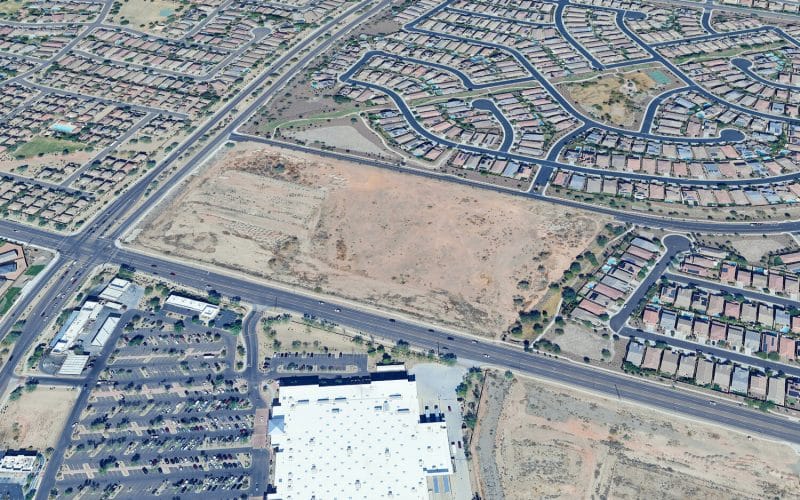By Paul Basha, traffic engineer, Summit Land Management


Like all things traffic, there’s always the good, the bad. (Extra points for anyone who did not think “and the ugly”.)
Right-turn lanes are great for cars turning right, and for cars following them. Though not always the right choice. (So that’s the reason we say right-hand turn: to distinguish between correct and not left!) {Like never trusting a skinny baker, never trust a traffic engineer who says left-hand-turn.}
While we’re not on the subject, would someone please explain why we park in driveways and drive on parkways?
On the left is a perfect example of good use of right-turn lanes, for two driveways and one street. All three locations are widely separated. Each location has its own right-turn lane. No confusion about who is turning where.
On the right is a perfect example of bad use of right-turn lanes. One continuous right-turn lane for four driveways and one street. Drivers turning right are uncertain as to which driveway is the business they are seeking. Drivers exiting are uncertain as to where the vehicles in the rightturn lane are turning right: the closest driveway to the approaching car or a driveway past the exiting car?
The traffic engineer for the community in the photograph on the right tells me this location has numerous collisions and frequent complaints because of the continuous right-turn lane.
Notice the help provided by the median in the left-most photograph. The businesses in the rightmost photograph like the frequent full access, and wish people would not collide with each other.
The photograph below is a perfect location for a right-turn lane on an arterial intersecting with another arterial. Bad world it would be if all those right-turning vehicles had to shuffle with all those through vehicles and also could not turn right-on-red.

As mentioned in two previous columns, right-turn lanes and right-turn arrows do not mix well with u-turns and left-turn arrows. The photograph below is a Scottsdale intersection with right turn lanes on three approaches necessitating three no u-turn signs. The eastbound-to-southbound approach does not have a right-turn lane so the northbound-to-southbound u-turn is allowed. Since there is no separate right-turn lane, there is no right-turn arrow, so there is no conflict with the corresponding u-turn arrow.

Which is better? Depends on where I’m going as I pay for the roads and traffic signals – others are definitely less important and can wait.
Right-turn lanes are particularly difficult with bicycle lanes. Right-turning vehicles are forced to watch for bicyclists as they cross the bicycle lane to enter the motor vehicle right-turn lane. This required extra vigilance wreaks havoc with their texting.

Right-turn lanes and pedestrians. If God had intended for us to walk, we would never have been provided cars. So, this intersection in Scottsdale has parks and houses on both sides of the road. People should be required by law to only use the park on their side of the major street!

Notice that our Avatar-sized pedestrian has to cross three through motor vehicle lanes-per-direction plus a left-turn lane and a right-turn lane. That’s eight lanes for a distance of 105 feet. Crossing that extra right-turn lane exposes the pedestrian to those big fast cars longer causing a greater accident potential. Plus, with the right-turn-on-red, the driver of the right-turning car might not see the pedestrian, as they hurry on their way.
A car requires 9.0 seconds for a driver to notice the light turned green, look left and right, and accelerate comfortably across an eight-lane street. Typical walking speeds are 3 to 6 feet-per-second, though most people can easily walk 9 feet-per-second. The Manual on Uniform Traffic Control Devices requires pedestrian signal timing to use a walking speed of 3.5 feet-per-second. That 105 feet requires 30 seconds to cross. So, all those cars must wait an additional 21 seconds for a pedestrian beyond what they would wait for a car.
The right-turn lane width of 11 feet alone requires 3.1 seconds. The additional 21 seconds for a pedestrian would be reduced to 18 seconds if the right-turn lane were not there. So, the rightturn lane is good for cars turning right – especially a right-turn-on-red. However, all those through vehicles must wait an additional 3 seconds or 17% longer so those right-turning vehicles can have a right-turn lane.
(That’s the reason many cities have pedestrian pushbuttons, so drivers need to wait for the WALK time only when pedestrians are present.)
Right-turn lanes are kind of like being at the eye doctor, with those big heavy black machines with varying lenses on your nose, and the polite patient medical technician asking whether 1 or 2 or 3 or 4 is better. Sometimes, it’s obvious, other times, only the self-delusional arrogant pretend to be certain.
Curious about something traffic? Call or e-mail Paul at (480) 505-3931 and pbasha@summitlandmgmt.com.








